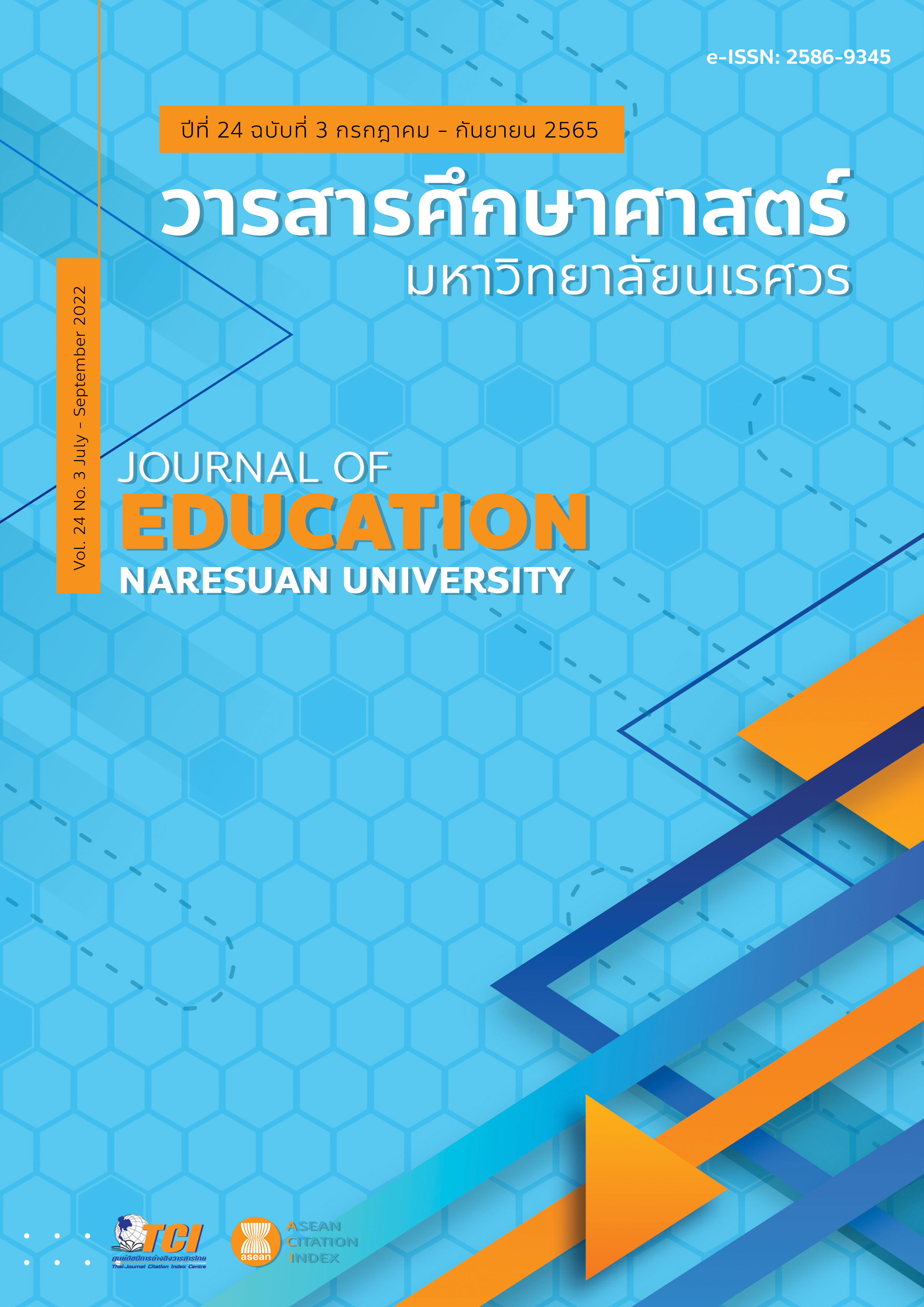THE CONSTRUCTION AND VALIDATION OF THE COGNITIVE MODEL OF FORCE AND MOTION FOR A DIAGNOSIS OF MISCONCEPTIONS
Main Article Content
Abstract
The cognitively diagnostic assessment (CDA) gives importance to learners’ thinking processes in doing a test. Its aim is to provide detailed feedback to learners on their mastery of predetermined attributes to improve their learning. It is appropriate to apply the CDA to construct diagnostic tests to uncover misconceptions about force and motion. We classified 27 synthesized misconceptions about force and motion into six categories: 1) resultant force, 2) Newton’s first law of motion, 3) Newton’s second law of motion, 4) Newton’s third law of motion, 5) frictional force, and 6) gravitational force. Then, we determined the hierarchical relationships among categories to construct the cognitive model of force and motion, which was validated by seven experts on the subject matter. The preliminary results in this study are the basis for the construction of diagnostic tests integrated with the CDA. The guidelines for constructing the tests to diagnose misconceptions about force and motion are discussed in the discussions and suggestions section.
Article Details

This work is licensed under a Creative Commons Attribution-NonCommercial-NoDerivatives 4.0 International License.
The owner of the article does not copy or violate any of its copyright. If any copyright infringement occurs or prosecution, in any case, the Editorial Board is not involved in all the rights to the owner of the article to be performed.
References
Alonzo, A. C., & Steedle, J. T. (2009). Developing and assessing a force and motion learning progression. Science Education, 93(3), 389-421.
Atasoy, S., Kucuk, M., & Akdeniz, A. R. (2011). Remedying science student teachers’ misconceptions of force and motion using worksheets based on constructivist learning theory. Energy Education Science and Technology Part B: Social and Educational Studies, 3(4), 519-534.
Bayraktar, S. (2009). Misconceptions of Turkish pre-service teachers about force and motion. International Journal of Science and Mathematics Education, 7(2), 273-291.
Bradshaw, L., & Templin, J. (2014). Combining item response theory and diagnostic classification models: A psychometric model for scaling ability and diagnosing misconceptions. Psychometrika, 79(3), 403-425.
DiBello, L. V., Roussos, L. A., & Stout. W. (2007) Review of cognitively diagnostic assessment and a summary of psychometric models. In C. R. Rao & S. Sinharay (Eds.), Handbook of Statistics (Psychometrics vol 26) (pp. 970-1030). Amsterdam: North Holland.
Eryilmaz, A. (2002). Effects of conceptual assignments and conceptual change discussions on students' misconceptions and achievement regarding force and motion. Journal of research in science teaching, 39(10), 1001-1015.
Gierl, M. J., Alves C., & Renate, T. M. (2010). Using the attribute hierarchy method to make diagnostic inferences about examinees’ knowledge and skills in mathematics: An operational implementation of cognitive diagnostic assessment. International Journal of Testing, 10(4), 318-341.
Gorin, J. S. (2007). Test construction and diagnostic testing. In J. Leighton & M. J. Gierl (Eds.), Cognitive diagnostic assessment for education: Theory and applications (pp. 173-201). New York: Cambridge University Press.
Gurel, D. K., Eryılmaz, A., & McDermott, L. C. (2015). A review and comparison of diagnostic instruments to identify students' misconceptions in science. Eurasia Journal of Mathematics, Science & Technology Education, 11(5), 989-1008
Halloun, I. A., & Hestenes, D. (1985). Common sense concepts about motion. American Journal of Physics, 53(11), 1056-1065.
Handhika, J., Cari, C., Soeparmi, A., & Sunarno, W. (2016). Student conception and perception of Newton’s law. AIP Conference Proceedings, 1708, 070005.
Hestenes, D., Wells, M., & Swackhamer, G. (1992). Force concept inventory. The physics teacher, 30(3), 141-158.
Hung, S. P., & Huang, H. Y. (2019). A sequential process model for cognitive diagnostic assessment with repeated attempts. Applied psychological measurement, 43(7), 495-511.
Javidanmehr, Z., & Anani Sarab, M. R. (2017). Cognitive diagnostic assessment: Issues and considerations. International Journal of Language Testing, 7(2), 73-98.
Kuo, B. C., Chen, C. H., & de la Torre, J. (2018). A cognitive diagnosis model for identifying coexisting skills and misconceptions. Applied Psychological Measurement, 42(3), 179-191.
Kuo, B. C., Chen, C. H., Yang, C. W., & Mok, M. M. C. (2016). Cognitive diagnostic models for tests with multiple-choice and constructed-response items. Educational Psychology, 36(6), 1115-1133.
Kurniawan, Y. (2018). Investigation of the misconception in Newton II law. Jurnal Pena Sains, 5(1), 11-18.
Lee, Y. W., & Sawaki, Y. (2009). Cognitive diagnosis approaches to language assessment: An overview. Language Assessment Quarterly, 6(3), 172-189.
Liu, G., & Fang, N. (2016). Student misconceptions about force and acceleration in physics and engineering mechanics education. International Journal of Engineering Education, 32(1), 19-29.
Ma, W., & de la Torre, J. (2016). A sequential cognitive diagnosis model for polytomous responses. British Journal of Mathematical and Statistical Psychology, 69(3), 253-275.
Martin-Blas, T., Seidel, L., & Serrano-Fernández, A. (2010). Enhancing force concept inventory diagnostics to identify dominant misconceptions in first-year engineering physics. European Journal of Engineering Education, 35(6), 597-606.
Narjaikaew, P. (2013). Alternative conceptions of primary school teachers of science about force and motion. Procedia-Social and Behavioral Sciences, 88, 250-257.
Nichols, P. D. (1994). A framework for developing cognitively diagnostic assessments. Review of Educational Research, 64(4), 575-603.
Poutot, G., & Blandin, B. (2015). Exploration of students’ misconceptions in mechanics using the FCI. American Journal of Educational Research, 3(2), 116-120.
Rupp, A. A., & Templin, J. L. (2008). Unique characteristics of diagnostic classification models: A comprehensive review of the current state-of-the-art. Measurement, 6(4), 219-262.
Rupp, A. A., Templin, J., & Henson, R. A. (2010). Diagnostic Assessment: Theory, Methods, and Applications. New York: Guilford.
Stewart, J., Zabriskie, C., DeVore, S., & Stewart, G. (2018). Multidimensional item response theory and the Force Concept Inventory. Physical Review Physics Education Research, 14(1), 010137.
Tomara, M., Tselfes, V., & Gouscos, D. (2017). Instructional strategies to promote conceptual change about force and motion: A review of the literature. Themes in Science and Technology Education, 10(1), 1-16.
Tu, D., Wang, S., Cai, Y., Douglas, J., & Chang, H. H. (2019). Cognitive diagnostic models with attribute hierarchies: Model estimation with a restricted Q-matrix design. Applied psychological measurement, 43(4), 255-271.


